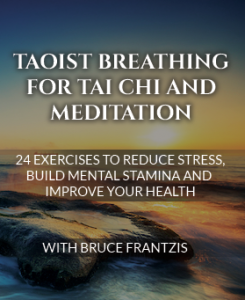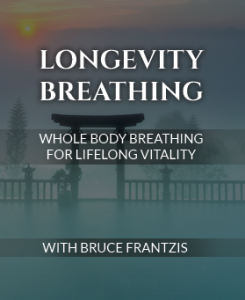Qigong breathing is based on Taoist breathing methods that focus on returning the way we breathe to what is in harmony with nature. These methods focus on creating a circular breath that starts from the belly and is relaxed. These methods can be practiced sitting or while doing any of the Energy Arts qigong exercise sets.
Breathe from Your Belly
Always breathe from your belly and not solely from your chest. This is the way you breathed when you were a baby. Belly breathing is the first step in learning Taoist Longevity Breathing practices and ideally should be incorporated into all Taoist qigong or tai chi practices. Belly breathing drops and lifts the big muscle of the diaphragm, the natural body mechanism that pushes air in and out of your lungs.
Belly breathing helps center your awareness in your body, rather than in your head, so that you feel more physically and energetically grounded. It helps you to relax your neck, shoulders and arms. It improves the circulation of blood and the flow of chi in your internal organs. Belly breathing provides a wonderful massage for your internal organs.
Just as massaging your muscles adds to their tone and overall functioning, so will belly breathing benefit your internal organs. In terms of your health, massaging your internal organs is more important than toning your visible muscles. Belly breathing increases the blood circulation in the blood vessels that nourish your internal organs.
Ideally, inhale and exhale only through your nostrils. If medical reasons make this impractical, inhale through your nose and exhale through your mouth. Inhale and exhale through your mouth only as a last resort.
- When you inhale, feel your breath come into your nose, down your throat and into your lungs and belly. Let your belly muscles expand to move your belly forward.
- When you exhale, let your belly return to its original position and relax. Do your best to completely relax your chest and not use any strength to puff it out when you breathe. You should have very little or no sense of air going into your chest.
- First, practice by focusing on expanding and relaxing your lower belly. Your lower belly extends from slightly above the top of your pubic hair to your navel. Breathe in such a way that the lower belly does not move from below the top of your pubic hair. Avoid straining or any feeling of pressure in your genitals.
- When you can expand and relax your lower belly comfortably, turn your attention to moving the middle belly when you breathe, which for most people is more difficult. The middle belly extends from your navel to just before your diaphragm. Placing your hands on the lower, middle and upper parts of your belly as you breathe will give you clear feedback as to whether and how much your belly is moving.
- Finally, concentrate on expanding and relaxing your upper belly—your diaphragm and solar plexus—just underneath your lowest ribs. Try to have your diaphragm move downward as you inhale and upward as you exhale. This will help push air into the back and top of your lungs, parts that seldom get exercised. Eventually, you will be able to move all three parts of your belly in unison.
Breathe Smoothly and Deeply
As you breathe, make both your inhales and exhales smooth and full, without strain. When your exhale is full, your next inhale will naturally and smoothly arise by itself. Conversely, if your last exhale is shallow and not full, your next inhale will not come smoothly.
You may have a tendency to hold your breath, gulp your inhale or even hyperventilate. Deep and smooth breathing enables you to take in and use more oxygen, better release carbon dioxide and calm your nerves. Over time, you take longer breaths, increasing the length of your inhale and exhale, without strain.
To get the sense of how to breathe smoothly and deeply, practice breathing from a straw for a few minutes a day, in a smooth and steady fashion. It will help you tune in to your breathing habits, and, over time, help you overcome poor ones. Often, lifetime habits of poor breathing can be overcome by practicing breathing with a straw for a few weeks.
Exhale Fully
Exhaling fully will get rid of the carbon dioxide in your cells and lungs and decrease its buildup in your cells, which produces sluggishness and yawning, diminishes mental clarity and increases stress. Exhaling fully will also make it easier for you to breathe in sufficient oxygen and make it easier for your cells to procure it.
You can do this in one of three ways.
The first is by exhaling a little more than you inhale. For example if you inhale for four seconds, you might take five seconds to exhale. This is the method to use when practicing breathing without doing any movements. You will use this method in Dragon and Tiger Movements 1, 3 and 4. The second method is to do an extremely rapid exhale (one or two seconds very forcibly).
If you find yourself getting sluggish or yawning, you can do three to ten forceful exhales and wake yourself up. Rapid exhales are used in Movement 5 of Dragon and Tiger.
The third way is to vary the speed of the exhale. For instance you might exhale 50 or 60 percent of your breath in the first two seconds and take four more seconds to exhale the rest of your breath. Dragon and Tiger Movements 2, 6 and 7 use this method.
Never Hold Your Breath
Focus on not holding your breath between the end of an inhale/exhale and the beginning of the next inhale/exhale. Let one flow into the other in as relaxed a manner as you can. Holding your breath can cause emotional tension and jangle your nervous system. Breathe smoothly and evenly, without stop-and-start breaks or jerkiness. Involuntarily holding the breath both triggers and escalates stress.
Keep the Tip of Your Tongue on the Roof of Your Mouth
As you breathe, keep the tip of your tongue touching the roof of your mouth. (If you make the sound “le,” as pronounced in the word “let,” your tongue will touch the correct spot just slightly behind your top front teeth.) Eventually, the muscles on the base of your tongue will stretch slightly and allow you to maintain this position comfortably, without effort. When your tongue touches the roof of your mouth, it continuously stimulates and balances all your body’s acupuncture meridians.
The twelve main acupuncture meridians of your body are all connected to points along the governing and conception vessels, which are two of acupuncture’s eight extraordinary meridians. The points along these two special meridians interface with and influence all the acupuncture points and meridians within your body. These two vessels form the chi pathway that is called the “microcosmic orbit.” That place just behind your upper front teeth on your hard palate is the acupuncture point where the governing and conception vessels meet. At this point, upward-flowing energy from yang meridians in the back of your body changes to downward-flowing energy in the yin meridians in the front of your body.
Only Breathe to 70 Percent of Your Capacity
There is no gain in putting tension in your body by straining to take longer inhales and exhales. Because breath is such a primary human function, it is quite possible to negatively pattern yourself and lock tension into your nervous system by forcing your breath. If breath induced tension lodges in your nervous system, the tension and stress will far outweigh the benefits of breathing quietly, softly and deeply in a relaxed manner. By staying within 70 percent of your capacity, you will wean yourself from pushing yourself and gain the habit of relaxation.
How to Practice Breathing
You can practice Longevity Breathing any time you remember to do so. The goal is to train the body to breathe this way twenty-four hours a day.
Learn Taoist breathing principles in more detail from Bruce’s book, Opening the Energy Gates of Your Body, or from his Taoist Longevity Breathing and Taoist Breathing for Tai Chi and Meditation systems.





0 Comments